Regula Reflex 2000 CTL
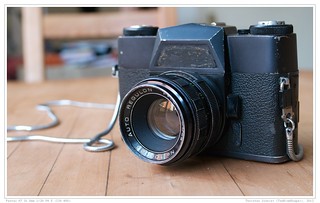
|
| Regula Reflex 2000 CTL + Auto Regulon 50mm f/1.8 lens image by Thorsten Schnier (Image rights) |
The Regula Reflex 2000 CTL is an SLR camera made by King KG in the late 1960's and early 1970's. This camera was also sold as the Ringfoto Reflex in Germany and as Kalimar Reflex in the US. This camera was developed by Joseph Op de Beek and first shown at Photokina in 1966 as the Regula Reflex CTL in two versions: M42 screw mount and Nikon F mount,[1] the M42 mount was only used in the end though.
The design of the camera is partly similar to the original Leicaflex SLR, some say also the focal plane shutter, shutter speeds and shutter mechanics, also incorporated things found on the Leicaflex SL (and many japanese cameras) like TTL metering and support for M42 lenses with A mode. The camera partly resembles basically to a simplified (and some would say prettier) Leicaflex intended to be sold much cheaper. Some features, specially of the shutter, e.g. the fastest time 1/2000, is also shared with the Leicaflex.
Only a website from Brazil says,[1] that unfortunately for King, the design was too similar and they were taken to court by Leitz and sued for infringing Leitz patents. There is no proof in the internet that Leitz won the case and King was ordered to pay fines for the infringements. The camera, arguably King's best, was a problem for the company, as it did not sell well enough: Japanese SLR were much more common, and sold much better. The public wasn't convinced that a factory that hadn't ever made an SLR, could make a good one. The Regula Reflex was killed off in the early 1970s. Ironically due to its rarity the Regula Reflex is now worth more than a Leicaflex in the camera collecting world. The camera was sold for about at least 7 years, which isn't a short time at all.
In 1976, drawings and the remaining parts were sold to National Instruments Calcutta in India who were building other Regula models for the internal market under licence, but the SLR was never pursued.
Specifications
- Takes M42 screw mount lenses, known standard lenses with the camera:
- Auto Regulon 50mm f/1.8 (rebranded Cosina Cosinon Auto 50mm f/1.8?) eventually was sold with this camera
- Isco-Göttingen Iscotar 50mm f/2.8 eventually was sold with this camera, also with Edixa SLR
- Steinheil Auto-Cassaron 50mm f/2.8 (the cheapest lens, original price DM 448,- with camera)
- Isco-Göttingen Regula Westromat 50mm f/1.9 (the standard lens, original price about DM 548,- with camera)
- Schneider-Kreuznach Xenon 50mm f/1.9 (the best lens, original price DM 698,- with camera)
- Depth of field preview lever by the lens mount
- TTL light metering by pressing a lever on the front next to the lens mount
- ISO 8-6400 settings for light metering
- Shutter speeds between 1 second and 1/2000th + bulb mode
- Hot shoe with electronic flash sync up to 1/125th (better than the Leicaflex's 1/90th)
- Self timer
- Special black coating, very durable
- Rather loud when exposing, as exposure and mirror flapping up and down happens nearly simultaneously. Although there is nearly no commotion of the camera when exposing, a coin standing on the camera won't fall down.
- Quick adjustment of exposure, as no LED-indication is used. On the right side of the viewfinder the full range of shutter speeds can be seen; when measuring, the needle that measures the light has to match the actual shutter speed, or vice versa. No automatic mode, all mechanical, except the TTL-measuring, that needs a mercury-battery.
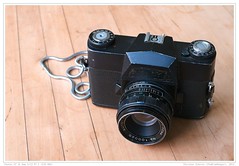
|
| Regula Reflex 2000 CTL image by Thorsten Schnier (Image rights) |
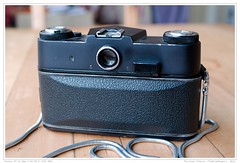
|
| Regula Reflex 2000 CTL - Rear image by Thorsten Schnier (Image rights) |
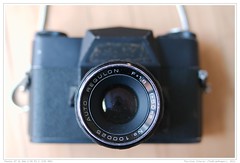
|
| Auto Regulon 50mm f/1.8 image by Thorsten Schnier (Image rights) |
Other versions
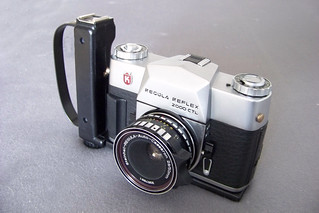
|
| Early prototype in chromium finish image by Christoph (Image rights) |
Besides the quite rare Regula Reflex 2000 CTL in all black finish (c 1969-1975, only about 5000 units seem to exist) McKeown's lists 3 other versions: There is a CTL (c 1967, similar to the 2000 CTL, but without shutter speed indicator in finder), a SL (c 1967, same without metering), and a K650 (c 1972, spot and average metering, shutter prio auto exposure, Nikon F mount). However, these versions seem to belong to the realm of myths. Nobody ever published a picture or any other proof of their existence, although others copied the listing and even collector price guidance.
In addition, there is a chromium/black version shown on the title of the user manual. Even this seem to never have found its way into production, although there is at least one early prototype existing, shown on the picture on the right.
Notes
Links
- A forum discussion on the Leicaflex case (in German), at the fotocommunity.de forum.
- Regula Reflex 2000 CTL, serial no. 4478 with the Auto-Cassaron, sold at the 23rd Westlicht Photographica Auction, on 25 May 2013. Several pictures of details of the camera.